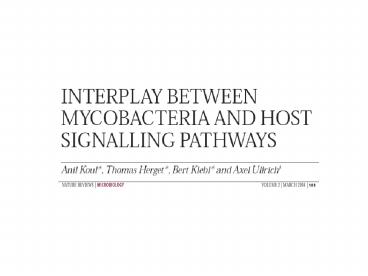Mycobacterium tuberculosis - PowerPoint PPT Presentation
Title:
Mycobacterium tuberculosis
Description:
http://nobelprize.org/physics/educational/microscopes/tem/gallery/7.html ... 1. Bacteria enter host cells. 2. Intracellular signaling cascades: ... Host cell targets: ... – PowerPoint PPT presentation
Number of Views:8878
Avg rating:3.0/5.0
Title: Mycobacterium tuberculosis
1
(No Transcript)
2
Mycobacterium tuberculosis
- Rod shaped bacilli most often cause lung
infections but can also cause disseminated
disease. - Tuberculosis may infect 1/3 of the world
population asymptomatically and causes 2
million deaths/year. - Airborne transmission most common, transmission
also possible via unpasteurized milk products. - Treatable but drug resistance can be problematic.
- Bacille Calmette-Guerin (BCG) vaccine available
but variable efficacy for adults.
http//www.cdc.gov/travel/diseases/tb.htm
3
Mycobacterium granulomas in the lung.
Mycobacteria bacilli look red with acid fast
stain.
http//www-medlib.med.utah.edu/WebPath/LUNGHTML/LU
NG031.html
4
(No Transcript)
5
Tuberculosis in the United States1953 84,304
cases 19,707 deaths. 2002 15,075 cases 802
deaths.In 2003 Sacramento 120 cases San
Francisco 162 cases.
http//www.cdc.gov/nchstp/tb/surv/surv2003.pdf
6
Mycobacteria
- Pathogenic species
- M. tuberculosis obligate intracellular
pathogen infections in humans gt animals. - M. bovis infections in animals gt humans.
- Non-pathogenic species
- M. smegmatis, M. vaccae.
- Survive in the environment.
7
Pathogenic Mycobacteria
- Survival inside macrophages.
- Intracellular signaling pathways altered
- Mitogen-activated protein kinases (MAPKs)
- Interferon-gamma (IFN-?)
- Calcium pathways (Ca)
- Host cell responses inhibited
- phasome-lysosome fusion
- apoptotic pathways
- bactericidal immune response
8
(No Transcript)
9
Phagosome maturation
- Normal maturation events
- 1. Phagocytosis of bacteria.
- 2. Acquire Rab5 (GTPase) and EEA1 (early endosome
antigen 1) to direct fusion of phagosomes with
early endosomes. - 3. Late phagosomes lose Rab5 but acquire Rab7,
along with LAMP proteins and cathepsin D (acid
hydrolase) by fusing with lysosomes. - 4. Vacuolar proton-ATPase molecules also acidify
the phagolysosomes.
10
Inhibition of phagosome killing
- Mycobacteria secrete vesicles containing lipids
and glycolipids that accumulate in
endosomal/lysosomal organelles to inhibit
phagosome maturation. - LAM is a cell wall glycolipid that can interfere
with phagosome maturation and apoptosis. - Man-LAM found in pathogenic mycobacteria.
- Ara-LAM found in non-pathogenic mycobacteria.
11
Inhibition of phagosomal killing
- Man-LAM suppresses the cytosolic Ca and
calmodulin increase needed for PI3 and EEA1
recruitment that leads to phagosome maturation,
as well as inhibiting delivery of acid
hydrolases. - TACO membrane proteins are associated with
Mycobacteria-infected phagosomes and may also be
involved with preventing lysosomal fusion. - Mycobacteria survive in phagosomes that have not
fused with lysosomes and so are not acidified. - Can Man-LAM be used as a novel TB drug target?
12
(No Transcript)
13
(No Transcript)
14
Apoptosis programmed cell death
- Extrinsic pathway Extracellular ligands (TNF-a,
FasL, etc.) bind to death receptors on cell
membrane. - Intrinsic pathway Intracellular translocation
of cytochrome c from mitochondria to cytosol.
-Both pathways lead to a caspase cascade, DNA
degradation, production of apoptotic bodies, and
antigen presentation.
http//nobelprize.org/physics/educational/microsco
pes/tem/gallery/7.html
15
Inhibition of apoptosis
- Mycobacterial Man-LAM
- -prevents the Ca increase that would increase
mitochondrial permeability and cytochrome c
release. - -activates the Akt cascade that phosphorylates
Bad to keep it from binding Bcl-2. Free Bcl-2
inhibits cytochrome c release and inhibits
caspase activity. - IL-10 production
- - releases TNFR2 to block TNF-a activity that
would activate the death receptor and external
apoptotic cascade.
16
(No Transcript)
17
When is suicide beneficial?
- While Mycobacteria inhibit apoptosis early in
infection, they can induce apoptosis during the
acute clinical phase why??
http//www-medlib.med.utah.edu/WebPath/INFEHTML/IN
FEC033.html
18
Innate Immune Response
- Normal events
- 1. Bacteria enter host cells
- 2. Intracellular signaling cascades
- MAPK (JNKs, ERKs, p38 MAPKs), JAK/STAT
- 3. Cytokines released
- IL-1, IL-6, IL-12, TNF-a, IFN-?
- 4. Increased tissue permeability and recruitment
of inflammatory cells to kill bacteria.
19
Inhibition of innate immunity
- MAPK pathway
- Less virulent Mycobacteria induce a sustained
- p38 signal cascade and immune response.
- More virulent Mycobacteria prevent sustained
activation of p38 and ERK signal cascades. - JAK/STAT
- Virulent Mycobacteria may cause a reduction of
IFN-? receptors that inhibit the JAK/STAT
cascade. - Mycobacterial lipids may induce SOCS expression
and inhibit the JAK/STAT signalling.
20
(No Transcript)
21
Adaptive Immune Response
- Normal events
- Dendritic cells phagocytose bacteria and present
antigen for T cell differentiation - T helper-1 cells IFN-? for intracellular
pathogens. - T helper-2 cells IL-4 for extracellular
pathogens. - Toll-like receptors (TLRs) and C-type lectins on
dendritic cells sense pathogens.
22
Inhibition of adaptive immunity
- Man-LAM binds the C-type lectin DC-SIGN
- inhibits dendritic cell maturation and T-cell
activation. - induces secretion of IL-10 to inhibit activated
dendritic cells (adaptive immune response) and
macrophages (innate immune response), as well as
inhibiting production of inflammatory cytokines
IL-12 and TNF-a.
23
(No Transcript)
24
Novel drugs needed
- Current TB treatment
- Multiple drugs used.
- 6-9 month treatment.
- Multi-drug resistance.
- Drugs target actively replicating bacteria but
persistent infections occur. - Most recent antibiotic was rifampicin in 1962.
25
Drug development
- Identify target proteins using mutant studies.
- 2. Use purified enzyme to screen compound
libraries. Consider compound activity, cellular
permeability, solubility, stability. - 3. Test compounds in vitro for MIC, toxicity
profiling, and selectivity profiling. - 4. Next test them in Mycobacteria-infected
macrophages and evaluate pharmacokinetic
properties to identify lead compounds for in
vivo testing in mice and clinical trials.
26
Novel drug targets
- Mycobacterial targets
- Kinases that phosphorylate host proteins.
- Phosphatases that dephosphorylate host proteins.
- Other enzymes (isocitrate lyase, synthases)
- Borrow concepts from cancer and diabetes research
for drug candidates. - Host cell targets
- Can we activate signalling systems that
Mycobacteria act to suppress to promote a
bactericidal response?
27
Can we stay ahead of our dependents (microbes,
etc.)?
- Shall we wait for chance discoveries as with
penicillin? Or use brute force and big funds to
test many drug targets? - Louis Pasteur "In the field of observation,
chance favors only the prepared mind."































![⚡Read✔[PDF] Zoonotic Tuberculosis: Mycobacterium bovis and Other Pathogenic PowerPoint PPT Presentation](https://s3.amazonaws.com/images.powershow.com/10094573.th0.jpg?_=202408090411)